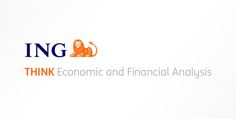BofA lifts gold target to $5,000/oz, sees silver staying in deficit
If the FX options market is any guide, and once this week’s big event risks are out of the way, investors are pricing a quiet August for markets. Low levels of volatility inevitably draw focus to the carry trade – a very popular strategy over recent months. Here, we backtest strategies and evaluate the risks and opportunities in the EMFX space
A Quiet August?
In theory, financial markets are shaping up for a quiet August – or at least, that’s what the FX market is telling us. Looking at the term structure of the EUR/USD traded volatility curve, expected volatility quickly falls away after this week’s event risks. One-month EUR/USD trades a full one vol under one-week implied volatility.
What’s left on the calendar is Friday’s job report and the 1 August US tariff deadlines. On the latter, the view seems to be that even if tariffs on some countries revert to ‘Liberation Day’ levels, they’re unlikely to stay there for long. The market now firmly believes that tariffs are transactional rather than ideological and that a baseline 15% duty can be secured should trading partners make sufficiently large commitments to spend or invest in the US.
While some strongly argue that the market is too complacent about tariffs, the question will be: what’s going to change in August? Many central bankers, politicians, and investors are away this month, and assuming high-profile trade deals – such as the US-China trade truce – are extended for another 90 days, the market default setting may well be ‘let’s pick this up in September’.
Perhaps the biggest risk now is that of secondary sanctions on the likes of China, India, and Turkey as Washington tries to turn the screws on Russia and those buying its cheap oil.
That said, cross-market levels of volatility continue to edge lower, and barring some big shock, it looks like volatility levels could remain low this August.
Cross-Market Volatility Is Subdued
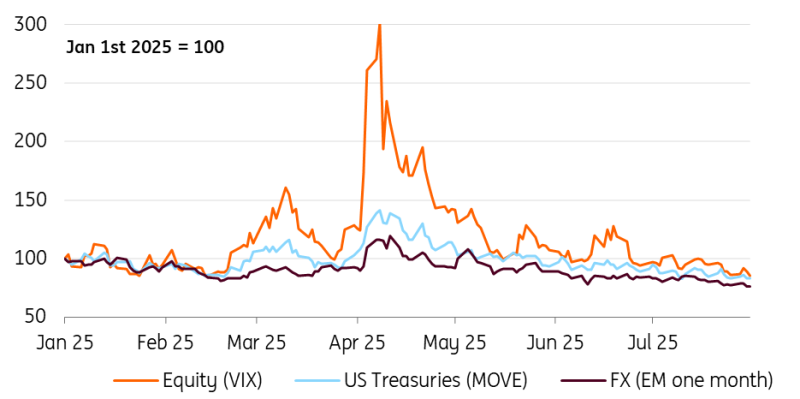
Source: Refinitiv, ING
Carry on Carry Trading
Low volatility inevitably brings attention back to the carry trade and the fundamental view that carry currencies will not depreciate as much as their high interest rates and financial theory suggest. In fact, a currency like the Egyptian pound not only offers annual interest in excess of 20% but has also appreciated against the dollar to deliver a 15% total return year-to-date.
We mention Egypt because a lot of the higher yields are to be found in emerging markets. These countries generally face higher inflation and have higher associated sovereign risks. These typically require higher rates of interest. FX investors can access these higher interest rates through the deliverable and non-deliverable FX forward markets.
But high yields need to be seen in the context of risk. There’s no point picking up pennies in front of the steamroller, after all. And that’s where the ‘carry-to-risk’ ratio comes in. Below, we adjust the one-month yields available through the FX forwards by implied – or expected volatility through the FX options market.
Leading the pack here are the super high-yielders of the Turkish lira and the Egyptian pound. And notably, the volatility-adjusted Indian rupee is more attractive than the Brazilian real – even though interest rates are twice as high in Brazil as in India.
Carry-to-Risk Ratios - or Volatility-Adjusted Implied Yields
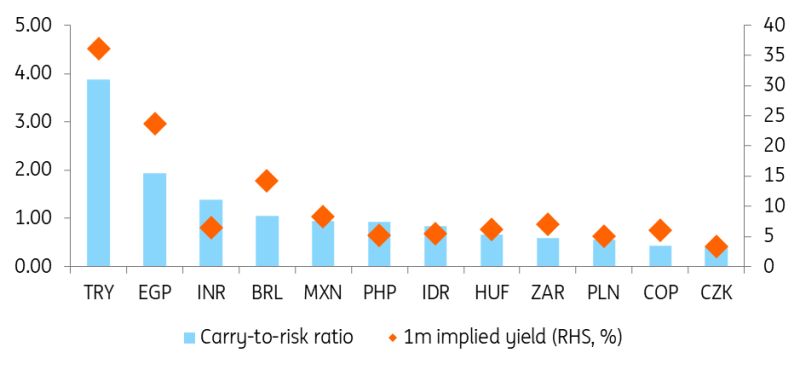
Source: Refinitiv, ING
Back Testing – A Few Important Points
Above, we’ve been discussing the high-yielding target currencies for the carry trade. The other half of the equation is which currency to fund from? Here, the focus in the G10 space has traditionally been the Japanese yen, with current borrowing costs at about 0.3% per annum. It is also very inexpensive to borrow in the Swiss franc. Or, for investors with a conviction call on direction, the US dollar has been a popular funding currency even though it has been reasonably expensive to borrow with rates above 4% per annum.
There are a myriad of permutations to look at when it comes to the carry trade, but in this exercise we’re looking at emerging market high yielders in four regional blocs: Middle East and Africa (Turkey, Egypt and South Africa), Asia (India, Indonesia and Philippines), Latam (Brazil, Mexico, Colombia) and Central and Eastern Europe (Poland, Hungary, Czech Republic).
Looking at these blocs in an equally weighted basket (e.g., Latam is 33% each for the Brazilian real, Mexican peso, and Colombian peso), we then backtest for the year-to-date performance with funding out of two separate examples: funding out of the dollar alone or funding out of an equally weighted basket of yen and Swiss francs.
Here’s how those strategies have performed.
Carry Trade Strategies Funded Out of USD
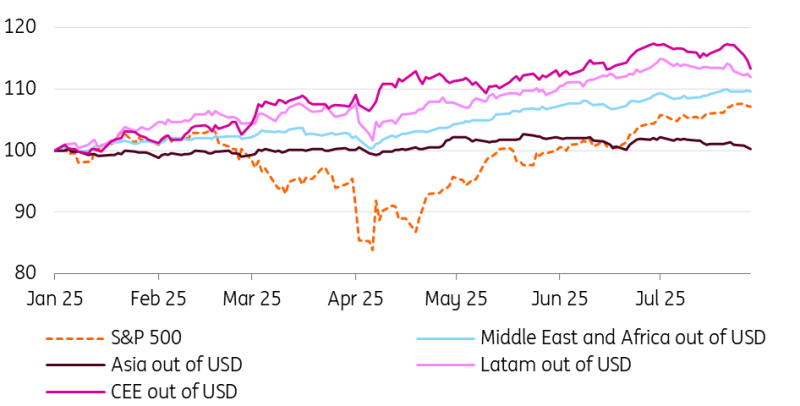
Source: ING calculations
And now funded out of an equally weighted basket of yen and Swiss francs:
Carry Trade Strategies Funded 50:50 Out of Yen and Swiss Franc
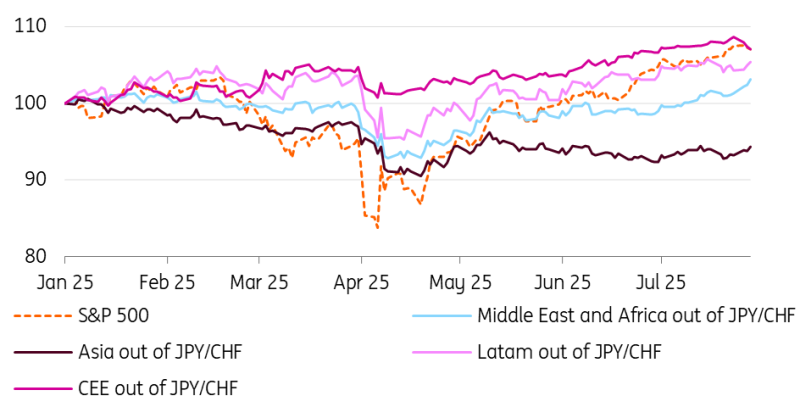
Source: ING calculations
It’s also important to look at some key financial metrics of these strategies, such as the maximum drawdown an investor might have suffered during the life of the strategy and the Sharpe Ratio – a measure of the volatility of those returns.
Financial Metrics of Carry Trade Strategies

Source: ING calculations
Some Observations
- Perhaps one obvious and one less obvious conclusion to start with. Carry trades funded out of the dollar have outperformed – no surprise given the well-documented decline in the dollar this year. But look at the larger maximum drawdowns when funded out of the yen and Swiss franc compared to dollar funding. Here, one can argue that many emerging market currencies (outside of Europe) are managed against the dollar, and the scope for adverse reactions (barring a crisis) is lower.
- Looking across the regional blocs, the outperformance of the CEE is just a function of the EUR/USD rally – and nearly all the gains are made up from spot rather than interest returns. Making a call on EUR/USD will be the driver for investing in the CEE bloc this August. Asia has distinctly underperformed. With some high drawdowns and low Sharpe Ratios, it seems clear that this region will not be at the leading edge of carry trade strategies. The Latam and Middle East blocs have performed pretty well as carry trade strategies, although they are not immune to setbacks – the Turkish lira’s near 4% fall in mid-March, for instance, when the Istanbul mayor was arrested.
The Road Ahead in August
Assuming neither US data nor the tariff story derails the idea of quiet trading conditions in August and carry trade strategies are in demand, what should we be looking at?
As above, dollar-funded carry trade strategies have outperformed so far this year, and after July’s corrective bounce, dollar-funded strategies may still be popular in August. Our view that EUR/USD probably finds support near the 1.13 area this month could once again favour CEE strategies for what is effectively a directional call rather than a carry trade strategy per se.
Regarding event risks in the CEE, investors will be wary of fiscal giveaways in Hungary ahead of next year’s elections, but at present, we doubt that risk will prompt a mass exodus from those chasing 6% implied yields in the forint. Elsewhere, the Czech koruna should hold its own, supported by the hawkish Czech National Bank. The downside for the Polish zloty looks relatively limited.
Latam offers high yields, and the biggest risk there now is probably the US-Brazil tariff spat. Tariffs have recently been raised to 50%, largely for political rather than trade-related reasons. Yet even these 50% tariffs had carve-outs for products like orange juice and aircraft parts. Plus, a seven-day delay in implementation still provides hope of a negotiated settlement. Mexico is still subject to tariffs on goods outside of the United States-Mexico-Canada Agreement (USMCA), but after a decent correction in USD/MXN to the 18.85 (and possibly above 19.00), we imagine carry trade investors will return to the peso.
For the very popular carry trades in Turkey and Egypt, we think investors can hold their nerve in August. After a setback for the lira in March, investors are closely following local politics in Turkey. Here, a big court case looking at the eligibility of Özgür Özel to lead the opposition Republican People’s Party (CHP) has been adjourned to September.
Elsewhere, foreign holdings of Egyptian t-bills must be very high now. Back in March, foreigners held $38bn – or nearly 50% of the total stock. UAE investment, FX liberalisation, and higher real rates have all helped the pound, and it’s not obvious what will rock the boat in August. Though the rand was in our MEA carry basket, it might prove a little more vulnerable this month as South Africa finds itself on the wrong side of the tracks with fellow BRICS members.
And Asia does not look that compelling in August. The biggest geopolitical risk we can see is a spike in oil prices as Washington seeks to push Russia towards a ceasefire. Higher oil prices are bad news for India and the Philippines, and India could also face some temporarily higher tariffs as this story plays out. We’d also argue that, given large FX reserves, Turkey might be better able to protect its currency than India from a spike in oil prices.
Disclaimer: This publication has been prepared by ING solely for information purposes irrespective of a particular user’s means, financial situation or investment objectives. The information does not constitute investment recommendation, and nor is it investment, legal or tax advice or an offer or solicitation to purchase or sell any financial instrument. Read more
